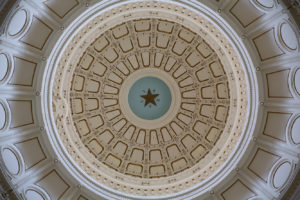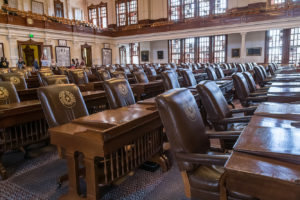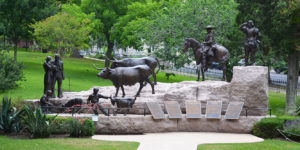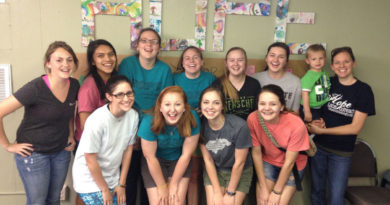Politics at Work: Texas State Capitol and Visitors Center
By Fred Afflerbach
Texans like to brag. We do it. We like it. We’re good at it. For example, most of us are happy to point out that the Texas Capitol is 14 feet taller than the U.S. Capitol. But a visit to that unmistakable landmark in downtown Austin reveals a surprising backstory. A monumental land swap, a stubborn governor who insisted on native Texas building materials and a labor strike all factored into construction of what was in 1888 the seventh-largest building in the world.
But most surprising about the Texas Capitol construction is probably the price tag: Zero. Zilch. Nada.
“One thing that people find amazing is that no taxpayer dollars were used to build the Capitol,” says tour director Elizabeth Garzone. “We traded land for it. We traded some 3 million acres of land to some developers from Chicago. And they spent their money to build the Capitol.”
 About 1.3 million folks tour the Capitol annually. That includes native Texans, newcomers, tourists from Europe, Africa, Asia. Many use the brochures available at the south entrance and venture out on their own. But even with a map, it’s easy to get lost in the cavernous maze of hallways and staircases and arches—and an underground extension larger than the original building. To keep from getting overwhelmed and to gather further insight, you can take a 45-minute tour.
About 1.3 million folks tour the Capitol annually. That includes native Texans, newcomers, tourists from Europe, Africa, Asia. Many use the brochures available at the south entrance and venture out on their own. But even with a map, it’s easy to get lost in the cavernous maze of hallways and staircases and arches—and an underground extension larger than the original building. To keep from getting overwhelmed and to gather further insight, you can take a 45-minute tour.
“The tour is going to give them the history of the building, a little bit about architecture and art and Texas history,” Garzone explains.
Guided tours begin every half hour to 45 minutes, seven days a week. Like construction costs from 130 years ago, they cost nothing. And that Texas hospitality we are so proud of is manifest in docents such as native Austinite Sarah Garcia.
“Everyone who works here as a tour guide is here because they want to be,” Garcia says. “And we have all walks of life. We have ladies in their 70s; and we have students.”
Inside the rotunda, recent Texas governors’ portraits look down on visitors. Ann Richards, George W. Bush and Rick Perry peer down at you from the circular limestone walls on the first floor while earlier governors’ portraits, such as Dan Moody and Miriam, “Ma,” Ferguson of Temple, hang upstairs.
Looking up from the art deco, terrazzo tile floor to the highest point of the dome interior may require a set of binoculars. From the Lone Star Seal on the floor to the Lone Star Seal affixed to the inside of the dome is 218 feet. Garcia says the Statue of Liberty without her pedestal would fit snugly inside the rotunda.

The two largest rooms in the capitol—House and Senate chambers—are living Texas history museums. Historic paintings of the Battle of the Alamo and San Jacinto, vintage wagon-wheel chandeliers and century-old walnut desks take you back to a time when horses and buggies rolled down Congress Avenue. Because the Capitol is a working office building, these rooms are off limits when the Senate and House are in session. (But the lawmakers meet for only 140 days on odd-numbered years.)
The 302-foot high Capitol sits on an emerald-green, 22-acre preserve in the heart of downtown. On a warm August morning, runners, bicyclists and a woman pushing a baby stroller crisscross the grounds on various sidewalks. A young couple poses under a mighty live oak for what looks like an engagement photo. Another woman has thrown a blanket on the lush grass and is reading a paperback. Among the towering pecans, oaks and elms, 21 statues help illuminate the Texas experience. From the early Spanish conquistadores, through the first Anglo settlements, to the Civil War and an African American History Memorial, Texas history comes to life through these bronze statues. A brochure for a self-guided tour of the Capitol grounds is available inside the south entrance.
Capitol Visitors Center Offers More Texas History
Adjacent to the Capitol grounds sits a medieval, castle-style building that housed the Texas General Land Office in the 1880s when noted author O. Henry worked there. Today it is home to the Capitol Visitors Center, a fascinating museum that serves as a worthy companion to the Capitol. (After touring the Capitol, your friendly tour guide will point you toward the Visitors Center.)
Here you will find a fascinating exhibit that details how a Chicago development company built the capitol with its own funds, about $3.7 million, in exchange for 3 million acres in the far reaches of the Panhandle. But in the1880s, the land was worth only about 50 cents an acre. Rather than selling it at a loss, the developers enlisted a successful cattle breeder and rancher, Burton, “Barbecue,” Campbell and founded the XIT Ranch.

Fencing the ranch was a monumental project. When all 240 railroad cars of barbed-wire were stretched from post to post, the fence ran 150 miles south along the New Mexico state line, then back east a short distance and160 miles northwest in a jigsaw route. The XIT at its zenith employed 130 men and owned nearly 1,900 horses. But low cattle prices, predators and rustlers hampered the operation. The XIT never turned a profit. It went out of business after 27 years when the owners had to begin selling parcels to pay creditors.
Another interesting exhibit chronicles how the deal between the state and the Chicago developer was rife with controversy and clouded with layers of dubious deals. After Governor John Ireland insisted on using Texas building materials, red granite quarried near Marble Falls was selected over an earlier choice, Indiana limestone, and construction was apparently ready to commence. But in a cost-cutting strategy, the Chicago developer demanded that cheap labor from a nearby prison be used. The state agreed to provide 500 convicts at 65 cents a day per man. A public protest then ensued with claims of using slave labor. But, according to the exhibit, “the real opposition came from a prolonged and bitter campaign launched by the Granite Cutters National Union. The controversy extended from Texas to Scotland to New York and provided a test for the newly enacted Alien Contract Labor Law.” The labor union eventually won a court battle in New York and construction resumed.
Regardless of whether you’re from the Lone Star State or one of the other 49, the friendly folks down in Austin are glad to point out the art, the history, the politics and architecture of our Capitol. But more importantly, they embody the true spirit of Texas—friendliness. Now that’s something to really brag about.
If you go
Texas State Capitol: 1100 Congress Ave., Austin, TX 78701
The building is open to the public weekdays from 7 a.m. to 10 p.m. and weekends from 9 a.m. to 8 p.m.
Free guided tours begin every 30 to 45 minutes: Monday–Friday 8:30 a.m. to 4:30 p.m.; Saturday 9:30 a.m. to 3:30p.m.; Sunday noon to 3:30 p.m. Check in at the south entrance. Teachers can book tours for their classes by calling ahead. Foreign language tours, large group tours also available. Call 512-305-8402
Free parking for the first two hours at the visitor parking garage: San Jacinto and 13th Street.
Information for special tours, such as Women in Texas History and Rest in Peace (for Halloween) can be found at tspb.texas.gov/plan/tours/tours.html




